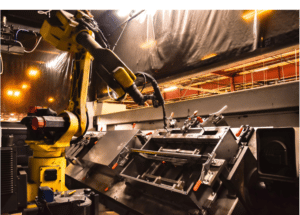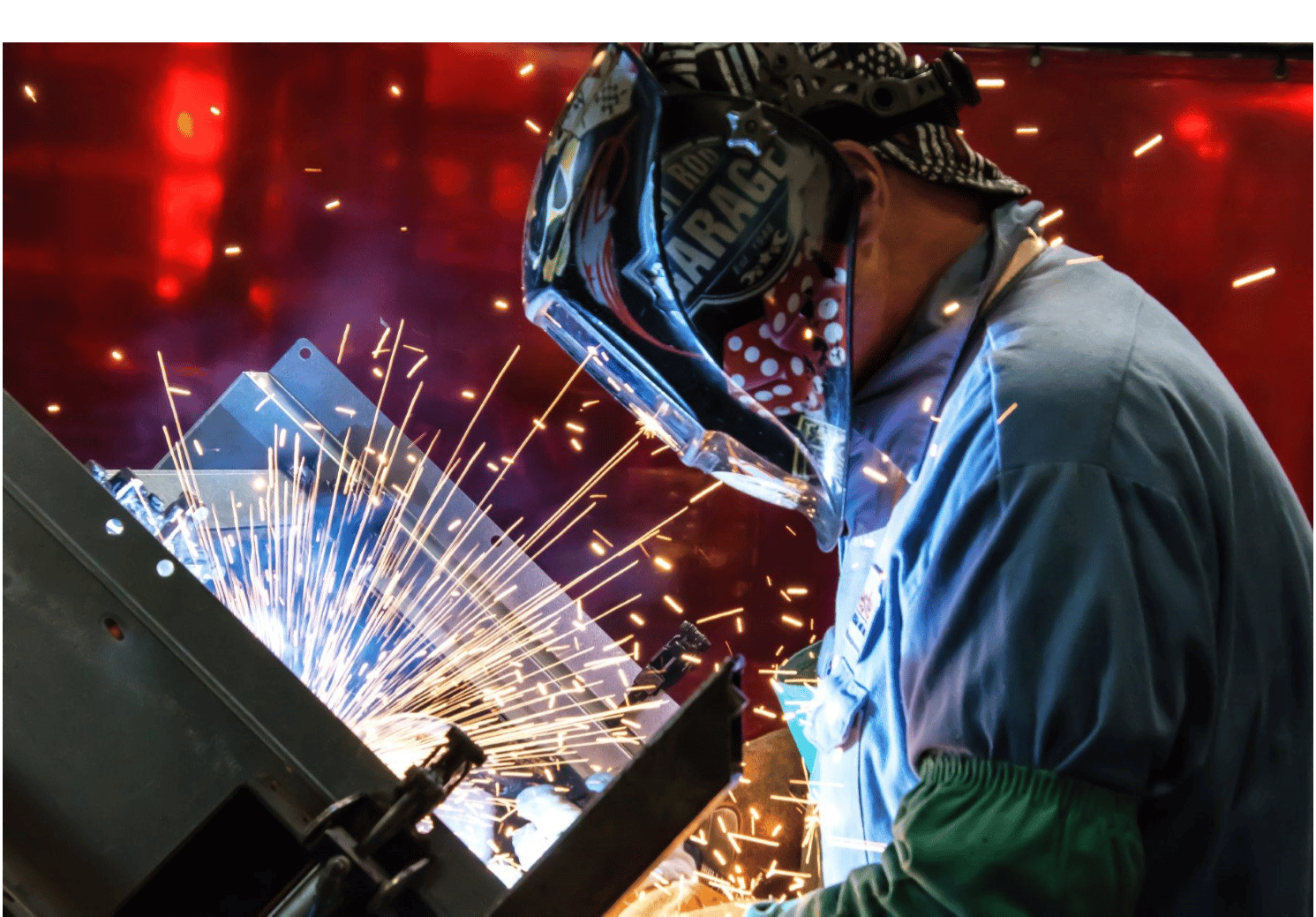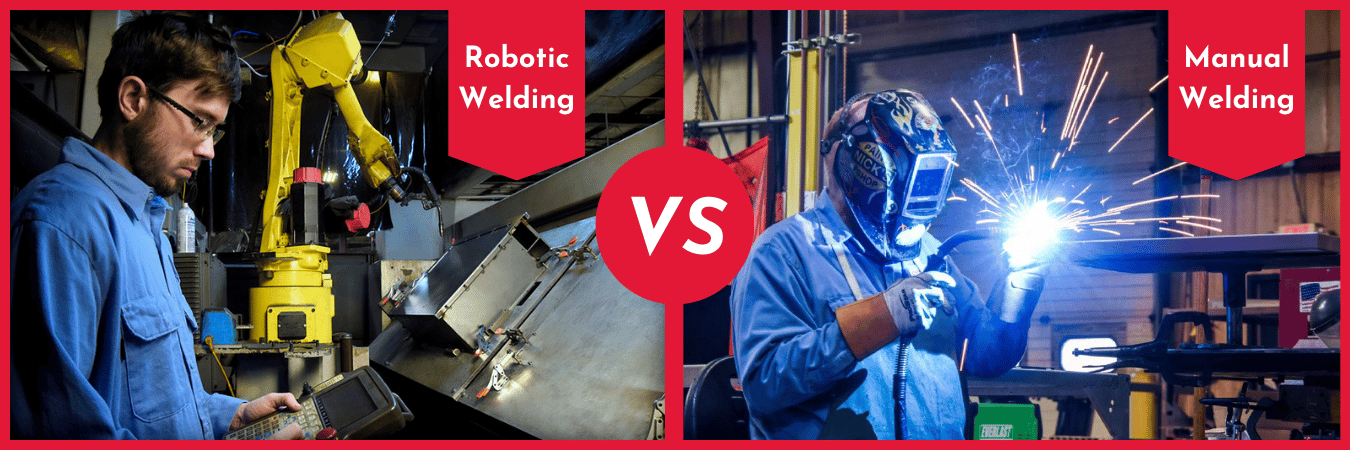In metal fabrication, welding is a central requirement that can be done either manually or automatically. What are the advantages of each method? Is robotic or manual welding the best choice for your project?
There are several advantages to robotic welding in a project. Robotic welding is:
- More efficient: Welding robots are often promoted as being faster than manual welders. While this is technically true, it is not because they weld faster; it is because they don’t slow down over the
 course of the day and they require less down time than humans, who get tired and need breaks. Welding robots can work virtually 24/7 with limited maintenance, and so their overall welding capacity is greater than a human’s. Robots increase through-put in high volume applications by using two fixtures and welding during the load/unload cycle of the secondary fixture.
course of the day and they require less down time than humans, who get tired and need breaks. Welding robots can work virtually 24/7 with limited maintenance, and so their overall welding capacity is greater than a human’s. Robots increase through-put in high volume applications by using two fixtures and welding during the load/unload cycle of the secondary fixture. - More cost-effective: Robots don’t have to be paid by the hour and will pay for themselves in the long-run. They also produce less waste because they make less mistakes than a human, minimizing scrap and rework costs. This results in highly repeatable, quality work.
- More reliable: Robots can repeat the same process over and over again with the same results. Especially for a high volume project, this ensures welds are done the same way every time. Human welding quality has a greater variance and mistakes are more common.
- Safer: Welding can be a dangerous task for humans. Robots can take on these jobs more safely, and the cost of an “injured” robot is much less than that of an injured person.
- More efficient: Welding robots are often promoted as being faster than manual welders. While this is technically true, it is not because they weld faster; it is because they don’t slow down over the
On the other hand, manual welding is still the better choice in some situations. Manual welding:
- Is more flexible: Human welders can continually make adjustments to the needs of the project in the middle of working. Once a robot has started working, the only way to modify its task is to stop and reprogram it. It cannot adapt to unforeseen circumstances or recognize a mistake.
- Requires no up-front costs: If you have a limited budget, manual welders can be the better short-term cost-effective choice. Robots save money in the long run, but they are expensive to initially acquire. If you have a limited budget, manual welders can be the better short-term cost-effective choice.
- Requires no reprogramming: When given a new project, a human welder can jump right in with little or no additional training. A robot, on the other hand, must be reprogrammed before every project, which takes time.
So what’s the best choice?
In short, it depends on the project. High-volume projects with the same welds over and over again will be most efficient when completed by a robot. Overall cycle time will be quicker and yield more accurate, consistent results. Additionally, the total cost of the project will typically be cheaper.
Smaller-volume or more technical work is best done manually. For smaller projects, the added reprogramming time the robot will require will in most cases not be worth the faster weld. Additionally, more complex projects will require the technical skills and flexibility of a human welder.
The good news?
Estes can help with both! We offer both manual and robotic welding services, as well as 3D laser welding. Our experts can help you asses which welding method is best for your project needs.
Superior quality welds are achieved through our PRIMA™ DOMINO – a 3D, 5-axis, laser welding system. The system’s automated robot arm aims a concentrated, high-powered beam of light at the metal workpiece. This action causes a localized area of the workpiece to heat up and melt, fusing two or more separate pieces together into a very precise joint. The resulting weld is extremely durable and attractive and is achieved without significantly distorting the surrounding metal. The Prima can weld steel and stainless up to 10x faster than traditional MIG welding and up to 40x faster than TIG welding. The machine is not only fast, but it also produces a product that requires minimal post-weld grinding or finishing – further reducing labor costs. You can learn more about the specifics of laser welding through our 3D Laser Welding Whitepaper series.
Our Genesis 4M Welding Robot is an automated welding system that helps increase weld quality, improve welding productivity, and decreases costs. The Genesis 4M Robotic Welding Cell is unique because it has 4 fixture beds that will accept a part 81 inches in length, 30 inches in width, and 10 inches in depth. The part is then presented to the robot via a double carousel positioner. The robot welds on one side of the table while the operator loads and unloads from the other – virtually doubling throughput. Additional throughput plus higher welding speeds results in lower labor costs.
Contact us today or request a quote to discover which type of welding is right for your sheet metal fabrication project!








